Under Eye Bag Treatment
Under-eye bags, dark circles, and puffiness can result from fluid retention, hyperpigmentation, excess skin, lack of sleep, collagen loss, and even a natural hollow in the undereye area. While these features may have a genetic component, they often worsen with frequent sun exposure or as part of the aging process. As we age, the structural proteins collagen and elastin diminish, leading to sagging skin and the migration of nearby fat into the space below the eyes. The combination of sagging skin and fat pad migration creates the appearance of under-eye bags. Many believe the only treatment available is invasive eyelid surgery or blepharoplasty. Thankfully, numerous non-surgical alternatives can rejuvenate the eyes. These non-invasive treatments provide rejuvenation results for the undereye area without downtime. If you’re interested in a non-surgical treatment option for enhancing the appearance of under-eye bags, Dr. Green in NYC is here to assist.
Dr. Green is an expert in cosmetic Dr. Green is an expert in cosmetic dermatology, specializing in rejuvenating the under-eye area through non-invasive procedures, including laser resurfacing, dermal fillers, chemical peels, and targeted skincare products. Laser treatments like eMatrix can enhance collagen production in the area, tightening the skin and reinforcing the skin’s structural network. Dermal fillers containing hyaluronic acid use this natural substance to restore lost volume, effectively addressing hollow tear troughs and dark circles from shadowing. The Mesopeel gently exfoliates the skin to target dark circles in the sensitive periocular region. Dr. Green’s proprietary line of skincare products, MGSKINLABs, Inc., features some of the finest active skincare ingredients that stimulate new collagen production, improve pigmentation, and reduce puffiness under the eyes. Patients can achieve a youthful appearance in their eye areas without undergoing plastic surgery.
Dr. Michele Green is an internationally renowned board-certified dermatologist with over twenty-five years of experience providing some of the world’s most discerning individuals with the finest non-invasive treatment options. Dr. Green takes a holistic approach and embraces a less-is-more philosophy regarding facial rejuvenation, customizing each patient’s plan to incorporate a unique combination of in-office treatment options and specially formulated skincare products that are best suited to their specific concerns and aesthetic goals. She is consistently recognized as one of New York City’s top dermatologists by New York Magazine, Castle Connolly, Super Doctors, and the New York Times for her dedication to patients and expertise. Dr. Green utilizes cutting-edge technologies and innovative treatment techniques to help her patients look and feel their best. Consulting with Dr. Green is the ideal first step if you are interested in removing fine lines and wrinkles, eliminating unwanted pigmentation and dark circles, and alleviating undereye bags without the need for invasive plastic surgery or blepharoplasty.
What are under-eye bags?
Under-eye bags are noticeable pockets of excess fat beneath the lower eyelids that may appear puffy, swollen, or saggy. These bags form when collagen breaks down within the skin, leading to weakened tissues and muscles in the undereye area. Collagen is a structural protein that provides support, contributing to a firm foundation and youthful appearance. As we age, collagen naturally decreases, resulting in thinner, weaker skin. These changes in the skin allow for fat and fluid to accumulate below the eyelids, creating the appearance of baggy under eyes. While under-eye bags do not require medical treatment, many individuals feel frustrated by their appearance and wish to address them. When you consult Dr. Green about your under-eye bags, she will assess your skin concerns and offer access to the best non-invasive treatments to enhance the appearance of your eyes.
What creates bags under the eyes?
Many patients often wonder, “What is the reason for bags under the eyes?” While there is a hereditary component to the appearance of under-eye bags, a wide variety of lifestyle choices can also contribute to their development. Risk factors for bags under the eyes include:
- Sun Exposure: The sun emits UV rays that can damage the skin’s structural components; therefore, sun exposure is one of the primary causes of aging signs around the eye area. Frequent sun exposure harms collagen and elastin fibers, potentially leading to sagging or drooping skin, which can make individuals appear to have excess skin under the eyes. A weakened support structure can allow fat to slip into the space beneath the eyes. Additionally, sun exposure can cause discoloration and other pigment-related issues, such as brown spots or sunspots.
- Genetics: There is a genetic component to the appearance of under-eye bags, although no single gene exists for their development. Some individuals are more prone to developing under-eye bags, and the likelihood increases if other family members, such as parents or siblings, have under-eye bags.
- Alcohol: Alcohol consumption can dehydrate the body, leading to dry eyes and weakened elasticity under the eyes. Increased skin laxity can allow for the accumulation of fat and fluid under the eyes, resulting in under-eye bags.
- Smoking: Smoking tobacco can accelerate the aging process and contribute to the appearance of under-eye bags. It produces substances that can reduce the amount of collagen and elastin in the skin. Additionally, smoking can restrict blood vessels in the skin, leading to reduced oxygen and nutrient delivery to the skin’s surface.
- Sleep Deprivation: Lack of sleep can lead to dark circles and bags under the eyes. Sleep deprivation may also cause blood vessels to dilate and fluid to accumulate in the under-eye area, resulting in puffiness.
- Diet: A diet high in salt can raise the body’s sodium levels, leading to excess fluid retention underneath the eyes.
How do you prevent under-eye bags?
The best way to prevent The best way to prevent under-eye bags is to reduce lifestyle habits that contribute to skin laxity or fluid retention beneath the eyes. Patients should avoid smoking, excessive alcohol consumption, and direct sun exposure to minimize collagen fiber damage in the skin. Using undereye creams containing vitamin C can promote the production of new collagen. Additionally, lowering salt intake can help prevent fluid retention, which is often the cause of under-eye puffiness. In some instances, under-eye bags cannot be avoided, as puffiness can result from genetics or the natural aging process. If that is the case, patients can seek cosmetic treatments with Dr. Green in NYC to diminish the appearance of bags under the eyes.
How do you remove eye bags?
Undereye bags can give the skin a more aged appearance and can be incredibly frustrating to deal with. They form due to skin laxity and fluid retention beneath the eyes, and home remedies can only provide temporary relief from their appearance. Specific lifestyle changes can help minimize or prevent the formation of under-eye bags, including dietary adjustments, getting enough sleep, and maintaining adequate hydration. While these choices can reduce eye puffiness, individuals with genetic under-eye bags often require cosmetic treatment from a board-certified dermatologist, such as Dr. Michele Green in New York City, to improve their appearance.
Dr. Green offers a variety of non-surgical treatment options designed to effectively diminish the look of under-eye bags as well as other concerns related to the undereye area, including dark circles and fine lines, providing long-lasting, natural-looking results with minimal downtime. The initial step in addressing undereye bags is to consult with a board-certified dermatologist like Dr. Michele Green. During your consultation, she will evaluate your medical history and the undereye area to develop a customized treatment plan aimed at rejuvenating your under eyes and reducing the appearance of eye bags.
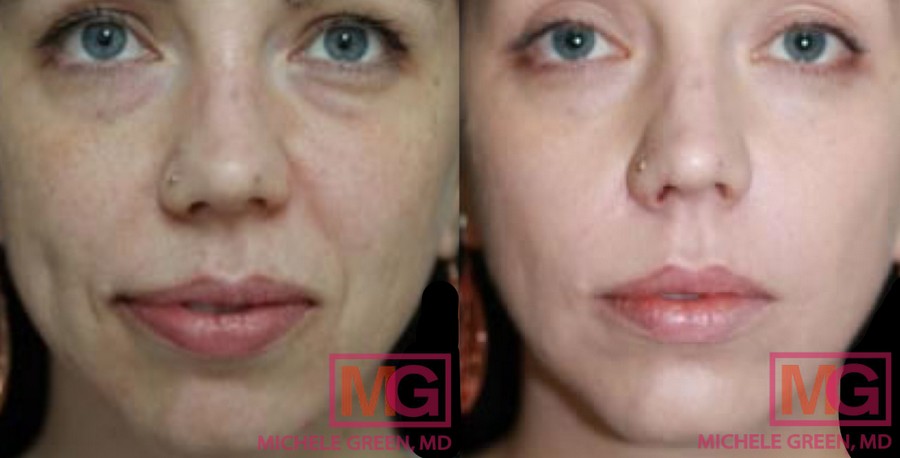
How to reduce the appearance of under-eye bags with Thermage Treatment
Thermage is the gold standard for non-invasive skin tightening, including the delicate Thermage is considered the gold standard for non-invasive skin tightening, including the sensitive under-eye area. Thermage utilizes radiofrequency energy to stimulate collagen production in the skin, resulting in firmer, smoother, and younger-looking skin. Thermage helps tighten the skin around the eyes and diminishes the appearance of mild under-eye bags caused by skin laxity. Besides enhancing the look of loose, excess skin around the eyes, Thermage can also be employed for skin tightening on the rest of the face, neck, chest, décolletage, upper arms, abdomen, buttocks, and thighs. There is no downtime associated with the treatment, allowing patients to return to their normal daily activities right after the procedure.
Skincare products to reduce the appearance of under-eye bags
Choosing the right Choosing the right skincare products for under-eye rejuvenation from the many over-the-counter options can be overwhelming. Therefore, it is always advisable to consult with an experienced board-certified dermatologist like Dr. Michele Green in New York. Dr. Green specializes in identifying the best skincare products to meet her patients’ needs and offers a proprietary line called MGSKINLABs. During your consultation, Dr. Green will assess your specific skin concerns under the eyes and create a skincare regimen tailored to give you a clear, bright, and youthful-looking undereye area.
Retinol is one of the best products for use under the eyes to restore skin firmness and reduce the appearance of fine lines and wrinkles. Derived from vitamin A, retinol brightens the skin beneath the eyes, boosts collagen production, and smooths fine lines and wrinkles. The Line Repair from MGSKINLABS contains retinol to stimulate collagen production, reduce skin laxity and fine lines, and rejuvenate the eye area.
Hydrating eye creams can also be applied under the eyes to enhance suppleness and plumpness in the area. Intensive Eye Repair from MGSKINLABs is formulated to reduce the visibility of fine lines, puffiness, and dark circles, while also tightening and firming the delicate skin around the eyes.
Sunscreen is one of the most crucial steps in any skincare routine. It is essential for protecting the skin from harmful UV rays, which can damage collagen fibers and lead to skin laxity, as well as the development of under-eye bags and dark circles. For optimal sun protection, patients should apply a broad-spectrum sunscreen with a minimum SPF of 50. The MGSKINLABs line offers a Hydrating SPF 50 containing zinc oxide to shield against UVA and UVB rays, along with lactic acid and hyaluronic acid to soften and hydrate the skin. In addition to safeguarding the delicate under-eye area with sunscreen, patients should also wear sunglasses and a hat when outdoors to minimize sun exposure under the eyes.
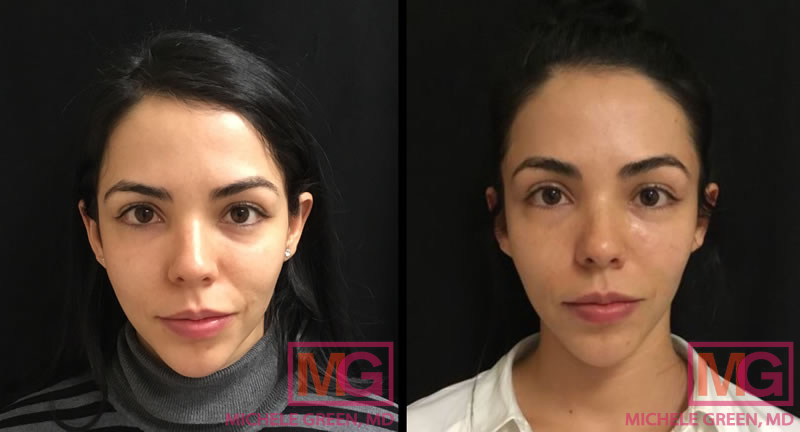
How to get rid of eye bags naturally
Several home remedies can enhance the appearance of under-eye bags. Getting adequate sleep may serve as an effective home remedy for reducing dark circles, puffiness, and under-eye bags. A simple cold compress can help diminish the appearance of under-eye bags caused by temporary swelling and fluid retention. The cold compress constricts blood vessels, which may temporarily reduce the visibility of dark circles or puffiness. Using tea bags on the under-eye area is a popular home remedy for momentarily alleviating under-eye bags, as tea contains antioxidants and anti-inflammatory properties that can decrease puffiness. However, the effectiveness of some treatment options has yet to be widely studied. If you experience under-eye bags, puffiness, dark circles, or hollows, it’s advisable to consult with an experienced board-certified dermatologist like Dr. Green before selecting any treatment option. When you consult with Dr. Green, she will recommend an at-home skincare routine that can enhance the appearance of your under-eyes.
How to remove eye bags permanently with Blepharoplasty eyelid surgery
Some patients choose to permanentlySome patients choose to permanently eliminate the appearance of unsightly undereye bags through a plastic surgery procedure known as blepharoplasty. During this procedure, an incision is made near the lower eyelid, and excess fat is removed. The surgeon then excises any surplus skin and muscle before closing the incision with small, dissolvable stitches. Common side effects associated with blepharoplasty include swelling and bruising around the eyes, which typically resolve within one to three weeks post-procedure. As an invasive surgery, blepharoplasty carries certain risks, including significant swelling and bruising, potential infection, and possible vision problems afterward. Most patients need approximately two weeks of recovery before resuming their usual activities. While blepharoplasty cannot halt the natural aging process, the cosmetic results can be exceptionally long-lasting. Many patients enjoy the benefits of lower lid blepharoplasty for life without needing repeat treatments. Besides its cosmetic advantages, the surgery can also address medical conditions related to vision problems caused by sagging excess skin. The best way to determine if you are a suitable candidate for blepharoplasty is to consult with a board-certified plastic surgeon or dermatologist.
For those who prefer to avoid the recovery associated with invasive For those who prefer to avoid the recovery associated with invasive plastic surgery, there are non-invasive alternatives that offer long-lasting results. It is essential to consult with an experienced board-certified dermatologist for under-eye rejuvenation to ensure the best outcomes and minimize potential side effects. An experienced board-certified dermatologist, like Dr. Michele Green in New York City, will evaluate the under-eye area to identify the cause of the eye bags’ appearance. Based on her expert assessment, Dr. Green will recommend a tailored combination of skincare products and non-invasive treatment options that best meet your specific needs, ensuring optimal results.
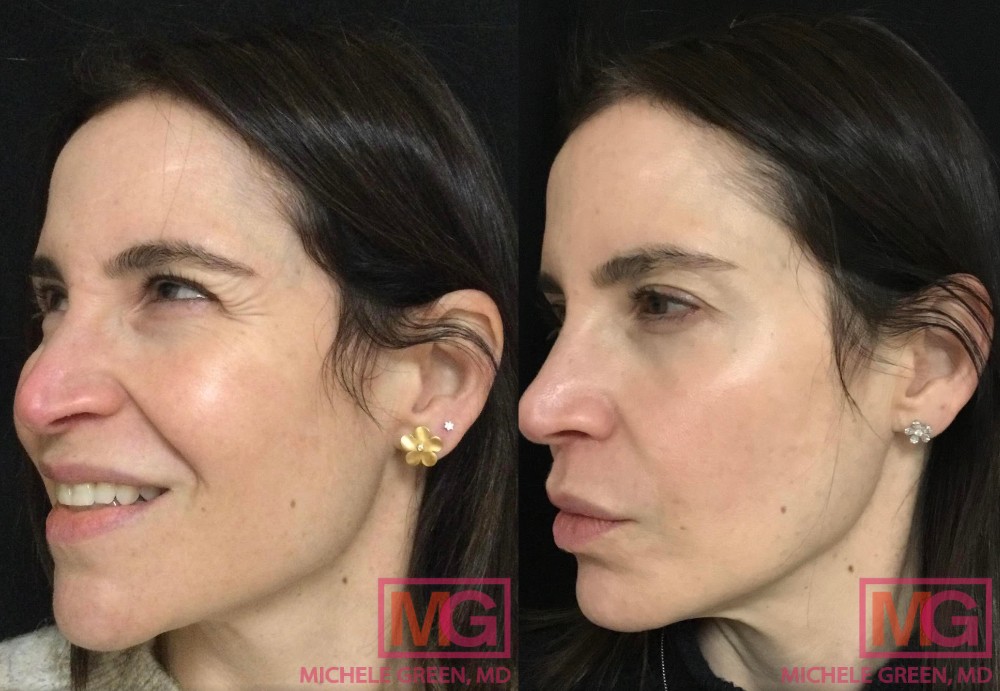
How to get rid of puffiness around the eyes
Eye puffiness, especially in the morning, often differs from age-related and genetic under-eye bags. It usually results from environmental and lifestyle factors such as diet (including salty foods), lack of sleep, chronic stress, hormone fluctuations, allergies, dehydration, and fluid retention. Puffy eyes are characterized by temporary swelling, which typically lasts just a few hours to a couple of days, although they may resemble under-eye bags. Puffiness caused by these factors may resolve on its own or require medical treatment, depending on the severity. Various home remedies and over-the-counter treatments can help reduce eye puffiness, such as taking an oral antihistamine, applying a cold compress, sleeping with your head slightly elevated (to prevent fluid retention), and limiting the intake of salty foods, alcohol, and tobacco. If you experience puffy eyes for an unknown reason, a board-certified dermatologist can help determine the cause. Dr. Michele Green in New York City can assist you in distinguishing between under-eye bags and puffy eyes, identifying the underlying cause, and creating a personalized treatment plan to rejuvenate the under-eye area.
How to get rid of dark circles under the eyes
Several contributing factors, including the Several factors, such as the aging process, lack of sleep, allergic reactions, dehydration, sun exposure, hyperpigmentation, lifestyle habits, or genetics, can lead to the appearance of dark under-eye circles. For some individuals, volume loss and hollowing beneath the eyes may cause shadowing, resulting in dark circles. Others might notice dark circles due to pigmentation or skin discoloration. It is essential to consult with an expert healthcare professional to understand the underlying cause of dark circles, as treatment options for volume loss and pigmentation vary significantly. Dr. Green is a board-certified dermatologist with over 25 years of experience in non-invasive treatment options for under-eye rejuvenation. During your consultation with Dr. Green regarding your dark circles, she will evaluate your unique facial anatomy and skin concerns to create a treatment plan for natural, youthful-looking under-eye rejuvenation.
Dermal Fillers to treat undereye hollowing
Many patients with dark circles in the under-eye area have genetic or age-related hollows. The tear trough hollows can create shadows under the eyes, resulting in the appearance of dark circles. Dermal fillers are a type of cosmetic injectable that can treat and reduce the visibility of under-eye bags and hollows caused by tear troughs or volume loss. There is a variety of dermal filler products, each with specific formulations and consistencies, making them suitable for different areas of the face. Within each family of dermal fillers, the thinnest gel injectable is typically used for the sensitive area under the eyes.
Dermal fillers, such as Restylane, Juvederm, and Belotero, consist of a smooth gel made from hyaluronic acid, a naturally occurring substance in the body that provides the skin with hydration and suppleness. When injected into the tear troughs, hyaluronic acid-based dermal fillers immediately restore volume to the skin, eliminating hollowing and dark circles for a more youthful appearance. Hyaluronic acid dermal fillers yield cosmetic results that usually last for six months, with most patients participating in regular follow-up treatment sessions to maintain optimal results.
Mesopeel Periocular to treat pigmentation and discoloration
Mesopeel is a specially formulated chemical peel designed to address all types of hyperpigmentation while helping to control melanocyte activity. The Mesopeel Periocular was developed specifically for use on the delicate skin under the eyes. It is tailored to treat the periorbital area and helps reduce dark circles caused by overactive melanocytes in the skin around the eyes. If you have tired-looking eyes and are seeking a non-surgical way to enhance their appearance, Mesopeel Periocular is an excellent anti-aging chemical peel for achieving eye rejuvenation. The treatment is quick, with zero downtime, and is safe for all skin tones, including darker complexions. Multiple treatment sessions spaced three to four weeks apart are necessary to see the best cosmetic results.
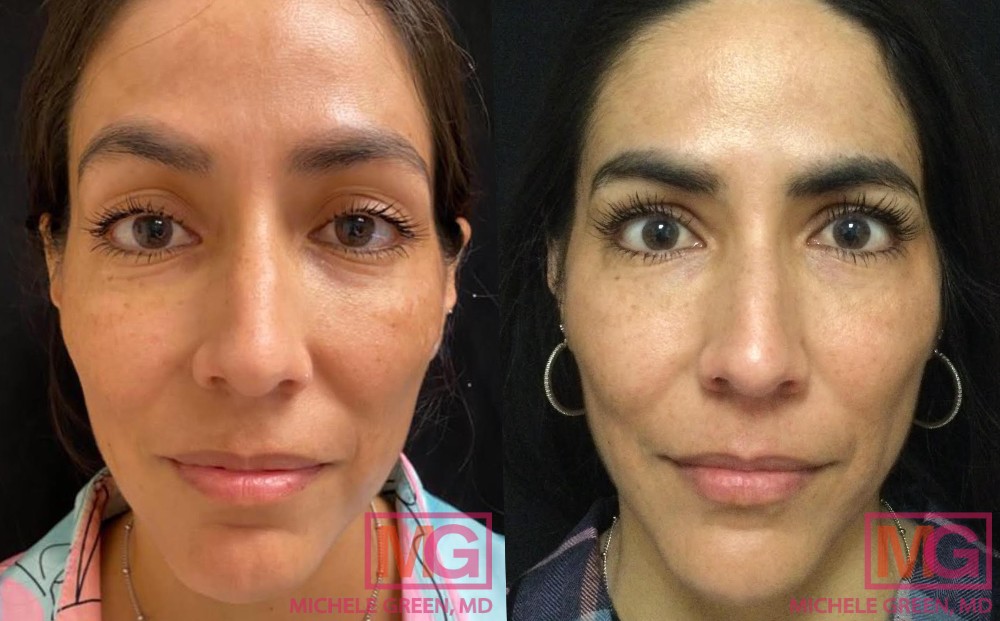
How to get rid of fine lines around the eyes
Botox treatment for crows feet reduction
Botox is an injectable neuromodulator treatment that gained FDA approval for cosmetic use in 2002. It inhibits targeted nerve signals, preventing certain muscles from contracting. Commonly applied to the forehead, glabella, and corners of the eyes (crow’s feet), it reduces the appearance of dynamic fine lines caused by repetitive facial expressions like smiling and squinting. When injected around the eyes, Botox creates a more ‘open’ look and minimizes fine lines. The effects become fully visible after two weeks and last for three to four months. Patients typically schedule regular maintenance sessions to sustain the treatment effects and smooth the fine lines around the eyes.
eMatrix laser for treatment of lines underneath the eyes
The eMatrix laser is a non-invasive resurfacing treatment designed to address signs of aging, including fine lines, wrinkles, and uneven skin texture. It utilizes bipolar radiofrequency energy to heat the inner dermal layer of the skin, stimulating the production of new collagen. The eMatrix applicator features a specialized tip aimed at treating and smoothing fine lines under the eyes. This laser is safe and effective for patients of all skin types and tones, including those with darker skin tones. There are approximately two days of downtime following the eMatrix treatment, during which patients may experience mild side effects such as redness, swelling, and tenderness in the treated area. Most patients require 3 to 6 sessions for optimal rejuvenation results.
Fraxel laser for undereye rejuvenation
Fraxel is often referred to as the ‘magic eraser’ for its unique ability to target a wide range of cosmetic concerns, including sun damage, pigmentation, fine lines, enlarged pores, and acne scars, among others. The Fraxel Dual Laser relies on fractional laser energy to create microscopic wounds in the treatment area, triggering the natural collagen production process. Its 1550nm setting addresses fine lines, wrinkles, and uneven skin texture, while its 1927nm setting targets sun spots, sun damage, and discoloration. When used beneath the eyes, Fraxel can help diminish the appearance of fine lines and pigmentation, resulting in a more youthful look. There is minimal downtime, and common side effects include mild redness, swelling, and tenderness in the treatment area, which typically resolves within 48 hours of the procedure. The initial results are usually visible approximately four weeks after a treatment session, and most patients require 3-6 treatment sessions, each spaced one month apart, to achieve optimal rejuvenation results.
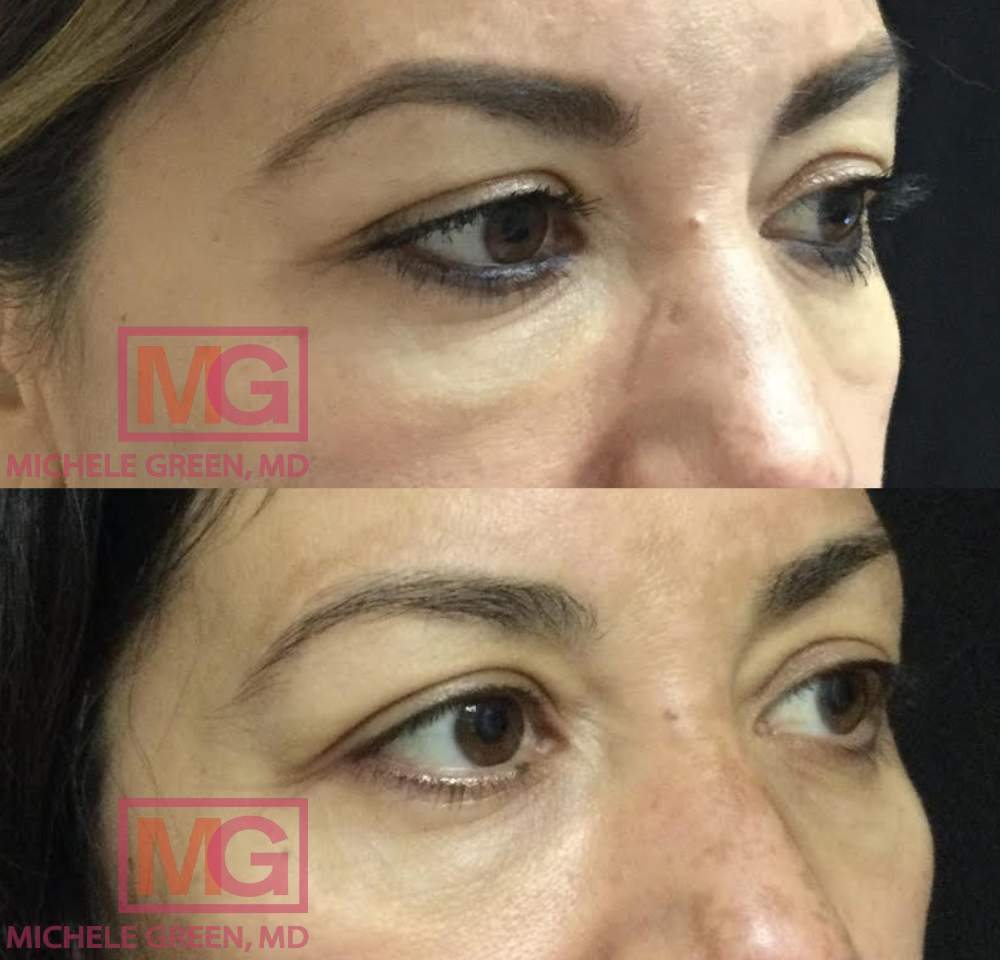
How to get rid of pouches under the eyes
Many patients seek non-surgical treatment options to reduce the appearance of under-eye bags instead of opting for invasive plastic surgery, which involves downtime and risks. At Dr. Green’s private dermatology office in New York City, she offers a variety of non-invasive treatments to enhance the under-eye area, such as dermal fillers, Botox injections, chemical peels, laser treatments, and specially formulated topical skincare products. These options provide patients with long-lasting rejuvenation results, and many individuals participate in regular follow-up sessions to maintain optimal cosmetic effects. While the non-invasive treatments yield enduring and satisfactory cosmetic outcomes for many, they do not provide permanent results. Your skin condition, specific concerns, and aesthetic goals will determine the most suitable treatment options. If you’re interested in non-surgical solutions for under-eye bags, consult your healthcare professional, Dr. Green.
What is the best retinol eye cream for under the eyes?
Retinol is a vitamin A derivative that accelerates skin cell turnover and promotes new collagen production. Increasing collagen production can enhance the appearance of dark circles by thickening the skin and reducing the visibility of blood vessels. Retinol also helps create firmer, smoother skin texture and diminishes the appearance of fine lines around the eyes. The retinol-based Line Repair eye cream from MGSKINLABs is an excellent addition to any nighttime skincare routine, contributing to a more youthful appearance in the under-eye area.
What is the best non-invasive treatment option for under-eye rejuvenation?
Patients often want to know what the best treatment option is for rejuvenating the delicate undereye area. No single treatment is superior, as patients frequently exhibit a combination of signs of aging beneath the eyes. Thermage effectively addresses skin laxity by stimulating collagen production in this area. Dermal fillers excel at treating shadowing beneath the eyes and restoring lost volume in the tear trough region. Mesopeel Periocular is a safe and effective option for reducing pigmentation and discoloration on the upper and lower eyelids.
Botox works best for dynamic wrinkles around the eyes that develop from repetitive smiling or squinting, while laser resurfacing treatments like eMatrix and Fraxel can diminish fine lines and wrinkles underneath the eyes. Dr. Green often recommends a combination of non-invasive treatments to achieve optimal results in eye rejuvenation. During your consultation with Dr. Green, she will assess your skin and gather a detailed medical history, including any health conditions and medications you are taking, before devising an individualized treatment plan that ensures a natural, youthful appearance that lasts.
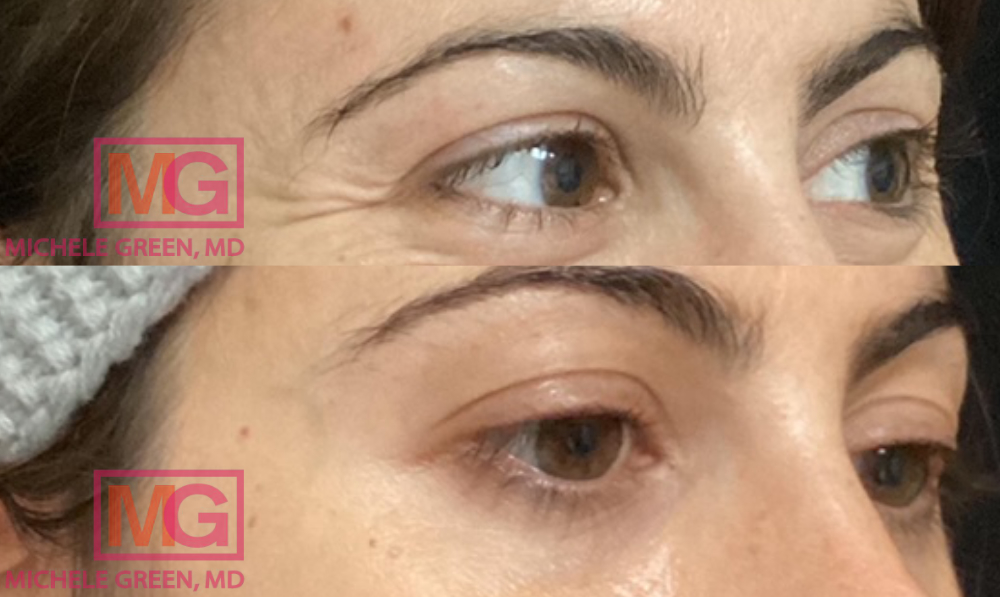
How to get rid of eye bags today
Undereye bags, puffiness, dark circles, fine lines, and hollows can create a prematurely aged appearance and, for many, induce feelings of self-consciousness. Although these features may have a genetic component, they often worsen with frequent sun exposure and other lifestyle habits such as insufficient sleep and poor diet. Eyelid surgery, or blepharoplasty, is one treatment option to enhance the appearance of undereye bags. However, surgical treatment isn’t always a feasible option, as it can be costly and invasive and involve significantly more downtime than non-surgical alternatives. Fortunately, numerous non-surgical options are now available to rejuvenate the eyes, including hyaluronic acid dermal fillers, chemical peels, laser resurfacing, Botox, and targeted skincare products that provide stunning rejuvenation results for the undereye area without downtime. If you’re interested in a non-surgical treatment option for enhancing the appearance of under-eye bags, dark circles, and puffiness, Dr. Green in NYC is here to assist you.
Dr. Michele Green is an internationally renowned, board-certified dermatologist with over 25 years of experience providing discerning individuals with top-notch non-invasive treatment options to enhance the appearance of under-eye bags. Dr. Green employs a holistic approach and embraces a less-is-more philosophy for facial rejuvenation, tailoring each patient’s plan to include a combination of in-office treatments and specially formulated skincare products best suited to their unique cosmetic concerns. She is consistently recognized as one of New York City’s top dermatologists by New York Magazine, Super Doctors, Castle Connolly, and the New York Times, thanks to her commitment to her patients and her expertise. To learn how to eliminate under-eye bags, schedule a consultation with Dr. Green at her private dermatology office located in Manhattan’s Upper East Side by contacting us online or by calling the NYC office at 212-535-3088 today.
 212-535-3088
212-535-3088